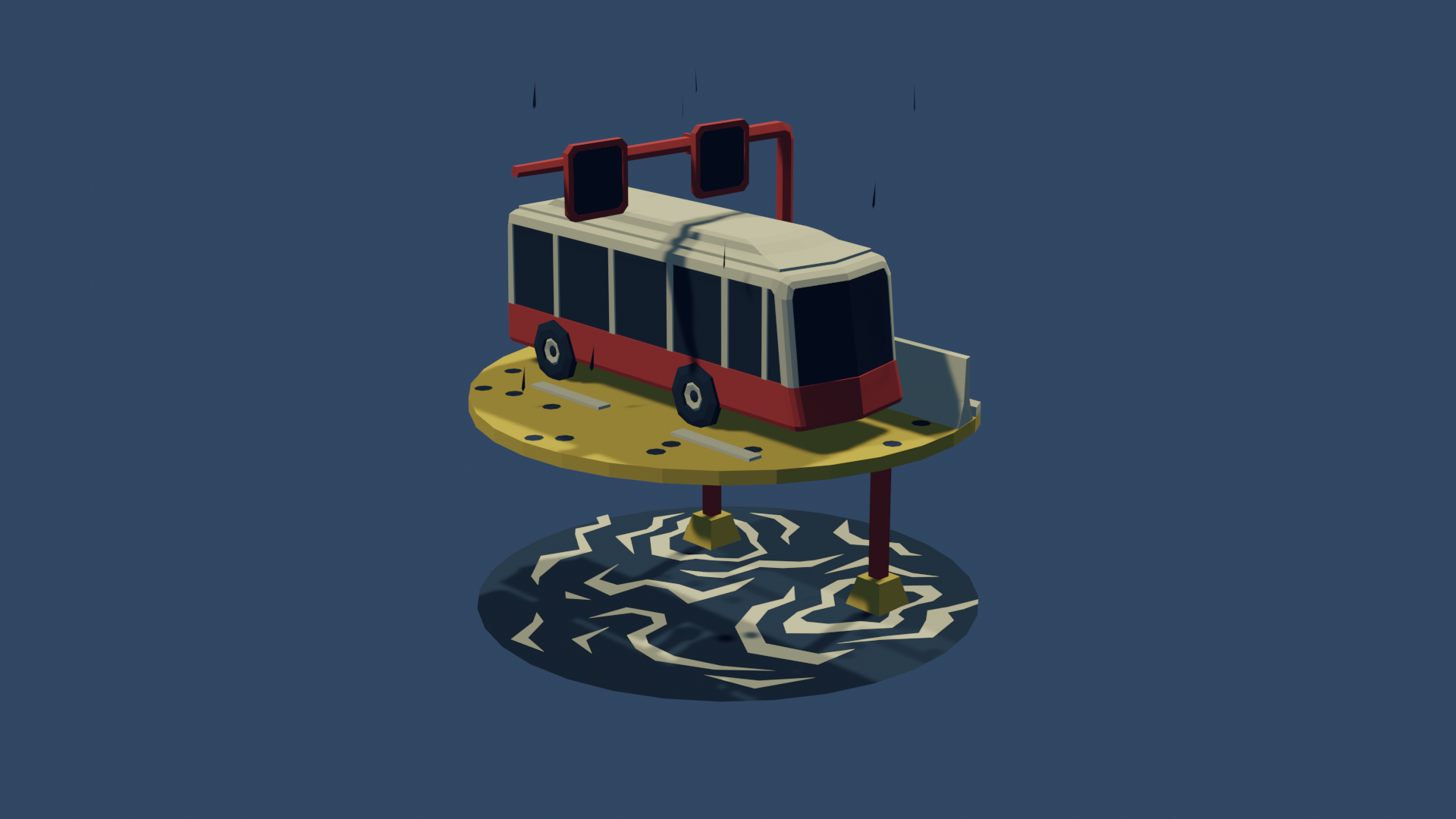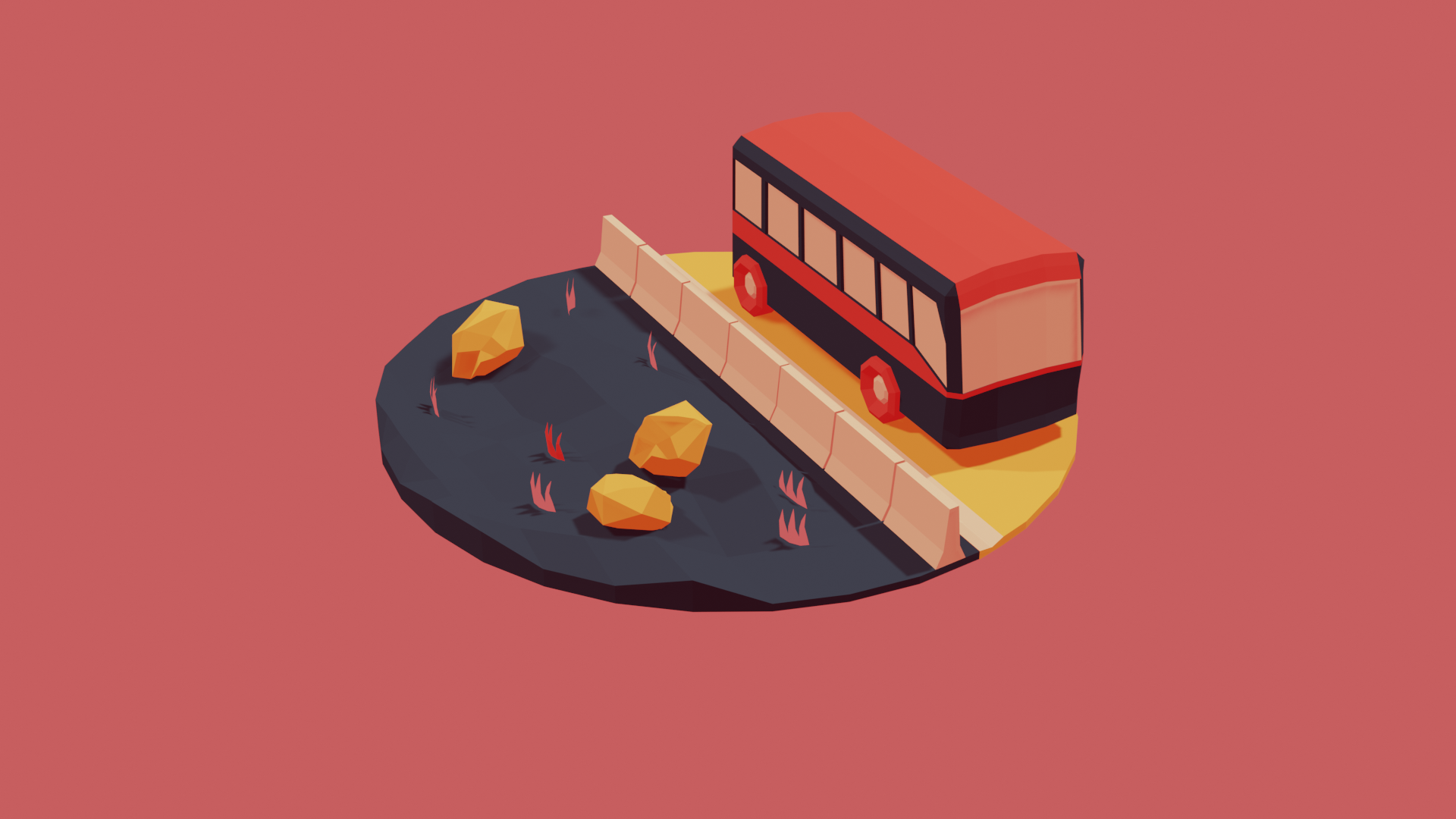SUMMARY
Record Collection is a series of four video turntables, each depicting a stylized 3d landscape which grows more complex in response to narration describing the environment. Each turntable features an unique narrator recalling a moment of tranquility, and describing the environment and emotions associated with that moment. Each feature described by the narrator is then depicted within the 3d environment and included in a slowly building soundscape. Low-poly 3D graphics and animated looping video are used to capture these memories within a virtual environment.
CONCEPT
project brief
As part of my senior media art program, I was assigned to create a work that showcased my practice and demonstrated my interests in order to present at the 4th Year Fall Show. The brief was very open, and I chose to incorporate my interest in spaces of digital interaction: creating virtual environments in which viewers can explore a location and toolset to interact with a crafted virtual environment. These environments take a variety and forms and serve a variety of purposes, often focusing on the possibilities of interaction within a natural space.
framing
I began by looking into examples of digital environments. I was especially influenced by Mylene Dreyer and Anias Voirol’s Out of Order, an example of a digital work with an extremely simple interaction method, which still manages to convey a playful tone that grows slowly more unsettling over its short duration through use of clever visual and sound design.
Another inspiration was Olia Lialina’s My Boyfriend Came Back From The War, One of the earliest examples of interactive narrative storytelling through a web format, exploring the possibilities of the web medium while using very simple interaction controls.
Screenshots from Out of Order and My Boyfriend Came Back From The War.
By minimizing the range of interaction methods down to simplified, singular actions, such as a mouse click or a camera movement, these works were able to focus on the possibilities of reaction to these inputs. These spaces attempt to create a sense of impact from minimal viewer disruption of the environment, positioning them as an observer rather than a vector of change or damage. This was a method I wanted to incorporate into my own work.
PROCESS
prototyping
Record Collection began as an exploration of how stylized digital objects can act as meditative environments, in contrast to the high speed and density of information present in most digital spaces. My goal was to create calming, minimalist digital environments that held the minimum required information to keep the viewer’s interest.
The first iteration of this project was MVT: Minimum Viable Tranquility, a series of three stylized digital environments composed of seamlessly looping 3d turntables and ambient soundscapes, each based on an archetypical “peaceful” location. They were displayed as a series of digital videos in the AUArts Screen Gallery.
REFINEMENT
recontextualizing
However, these environments lacked narrative, and in the next iteration each environment was based around an interview. These interviews asked participants to describe environments they found peaceful in order to recreate those spaces in a digital format. By recontextualizing an interview as narrative, a series of interviews were condensed down to several minutes and focused in order to emphasize visual descriptions of the environment, as well as the interviewee’s emotional state. I then isolated each element described in order to recreate the scene as a collection of 3d models.
The videos are displayed as a series of thumbnails on a web page, each labelled with the name of the narrator. As the narrator begins to describe the environment, those elements will begin to appear as stylized 3D models on the screen or be included as ambient audio files. The entire 3D environment rotates slowly, with each element fully contained within the “record”. The generative formation of the environment, as well as the steadily building complexity of the soundscape, creates a growing sense of immersion as the viewer is drawn into the memory being described, with the exclusion of the narrator from the visual environment allowing the viewer to insert themselves into the narrator’s memory. As the narration draws to a close the environment, now fully formed, begins to disappear in the reverse order it originally appeared, until all that is left is the same blank record from the beginning.
By capturing and then recontextualizing the memory of the narrator in a digital format, Record Collection explores the inconsistencies inherent to memories, storytelling, and recreation. The highly stylized environment, viewed from an outside perspective, is conscious of the fact that it cannot recreate the experience of the narrator, and yet includes a level of personal detail that renders the recontextualization impossible to separate from the original memory.
The resulting turntables explore the value put into archive and digital objects. Unlike physical craft that are by nature imperfect and therefore unique, each digital object has an ideal form. As a result, digital objects and the labour that goes into them are considered to have less value and emotional weight. Record Collection uses this perfection to explore the imperfection of memory and recreation, abstracting personal memories into single moments frozen in time.
The resulting videos draw from many signifiers of analog recording, such as record player clicks, film grain, and vocal crackling, drawing tension between the imperfect analog nature of memory versus the perfect abstraction of the digital. The resulting records are impersonal in their abstraction, yet deeply personal in their narratives.
REFLECTION
The final result of record collection was a complete series of works that were displayed at the AUArts Fall 4th Year Show. The project received an A grade in the class.
This project sparked an interest in the differences between physical and digital environments. These differences are especially prevalent in artifical structures such as architecture. Architecture is highly informed by the physical world: constraints of material, of location, and of human use. These constraints are often irrelevant to artificial structures recreated, or reimagined, in digital space. However, digital space comes with its own set of concerns: polygon counts, loading times, and use cases that are often uncommon in physical architecture such as combat or puzzle solving. Because digital architecture draws from its physical counterpart, I am interested in seeing which of these aspects are carried over vistigially versus which are discarded, and why.
Due to the direction started from this project, I am planning to write my senior thesis on the signifiers of physical architecture that are carried over into the digital.








